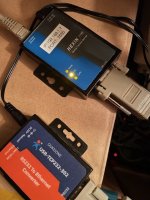Ok all I have made significant progress with the termcap's.. So there is a termcap file for the menu system and mostly each of the applications.. So I had to go searching for them all. I have been able to pretty much clear up any issues with most applciations except Uniplex. This is the Termcap for the VT100 and the VT220. I am using the VT220 to be able to use the function keys 1-10.. So now I have the opposite issue of what I had originally. I could use the function keys from F1 - F4... Now I can only use F5 - F10.. Perhaps someone might be able to suggest a solution? When I do depress the FN key followed by F1, F2, F3, F4 I get text in the document letters P, Q, R, S... I just need to figure out what characters I have to program in those spots as you can see below in the VT220 they are programmed EOP, EOQ, EOS. I have also put a few notes down below these termcaps that I found in a termcap file.. maybe that could be helpful.. any ideas would be greatly appreciated

d1|vt100|DEC VT100:\
:up=\E[1A:do=\E[1B:nd=\E[1C:bc=\E[1D:cm=\E[%i%d;%dH:ho=\E[H:\
:co#80:li#24:am:cl=50\E[;H\E[2J:bs:cm=5\E[%i%2;%2H:nd=\E[C:up=\E[A:\
:ce=3\E[K:cd=50\E[J:so=\E[7m:se=\E[m:us=\E[4m:ue=\E[m:\
:is=\E>\E[?3l\E[?4l\E[?5l\E[?7h\E[?8h:ks=\E[?1h\E=:ke=\E[?1l\E>:\
:if=/usr/lib/tabset/vt100:ku=\EOA:kd=\EOB:kr=\EOC:kl=\EOD:\
:kh=\E[H:k1=\EOP:k2=\EOQ:k3=\EOR:k4=\EOS: pt:sr=5\EM:
:am:le=^H:bs:li#24:co#80:cm=\EY%+ %+ :cd=\Ek:ce=\EK:nd=^F:\
:up=^Z:cl=^L:ll=^A:kl=^U:kr=^F:kd=^J:ku=^Z:kh=^A:\
:so=^N:se=^O:us=^N:ue=^O:is=^O\E0`:vs=^O\E0P:ve=^O\E0`:
d3|vt220|DEC VT220 in vt100 emulation mode:\
:ae=4\E(B:al=\E[L:am:as=2\E(<:\
:bl=^G:bs:\
:cd=50\E[J:ce=3\E[K:cl=50\E[;H\E[2J:cm=10\E[%i%d;%dH:\
:co#80:cr=^M:cs=\E[%i%d;%dr:\
:dc=\E[P:dl=\E[M:do=\E[B:ei=\E[4l:ho=\E[H:\
:if=/usr/lib/tabset/vt100:im=\E[4h:is=\E[1;24r\E[24;1H:\
:ke=\E>:ks=\E=:\
:k1=\EOP:k2=\EOQ:k3=\EOR:k4=\EOS:k5=\E[17~:\
:k6=\E[18~:k7=\E[19~:k8=\E[20~:k9=\E[21~:k0=\E[29~:\
:kb=^?:kd=\E[B:kl=\E[D:kr=\E[C:ku=\E[A:\
:le=^H:li#24:\
:mb=2\E[5m:md=2\E[1m:me=2\E[m:mi:mr=2\E[7m:\
:nd=\E[C:nl=^J: pt:\
:rc=\E8:rf=/usr/lib/tabset/vt100:\
:rs=\E>\E[?3l\E[?4l\E[?5l\E[?7h\E[?8h:\
:sc=\E7:se=\E[m:sf=\ED:so=\E[7m:sr=\EM:\
:ta=^I:ue=\E[m:up=\E[A:us=\E[4m:vt#3:xn:\
:GS=\E(0:GE=\E(B:\
:G1=k:G2=l:G3=m:G4=j:GV=x:GH=q:\
:GU=v:GD=w:GC=n:GL=u:GR=t:
These are other entries I found in another termcap file mentioning Fkeys 1-4
# vt220:
# This vt220 description maps F5--F9 to the second block of function keys
# at the top of the keyboard. The "DO" key is used as F10 to avoid conflict
# with the key marked (ESC) on the vt220. See vt220d for an alternate mapping.
# PF1--PF4 are used as F1--F4.
#
de|vt220|DEC VT220 in vt100 emulation mode:\
:ae=4\E(B:al=\E[L:am:as=2\E(<:\
:bl=^G:bs:\
:cd=50\E[J:ce=3\E[K:cl=50\E[;H\E[2J:cm=10\E[%i%d;%dH:\
:co#80:cr=^M:cs=\E[%i%d;%dr:\
:dc=\E[P:dl=\E[M:do=\E[B:ei=\E[4l:ho=\E[H:\
:if=/usr/lib/tabset/vt100:im=\E[4h:is=\E[1;24r\E[24;1H:\
:ke=\E>:ks=\E=:\
:k1=\EOP:k2=\EOQ:k3=\EOR:k4=\EOS:k5=\E[17~:\
:k6=\E[18~:k7=\E[19~:k8=\E[20~:k9=\E[21~:k0=\E[29~:\
:kb=^?:kd=\E[B:kl=\E[D:kr=\E[C:ku=\E[A:\
:le=^H:li#24:\
:mb=2\E[5m:md=2\E[1m:me=2\E[m:mi:mr=2\E[7m:\
:nd=\E[C:nl=^J: pt:\
:rc=\E8:rf=/usr/lib/tabset/vt100:\
:rs=\E>\E[?3l\E[?4l\E[?5l\E[?7h\E[?8h:\
:sc=\E7:se=\E[m:sf=\ED:so=\E[7m:sr=\EM:\
:ta=^I:ue=\E[m:up=\E[A:us=\E[4m:vt#3:xn:\
:GS=\E(0:GE=\E(B:\
:G1=k:G2=l:G3=m:G4=j:GV=x:GH=q:\
:GU=v:GD=w:GC=n:GL=u:GR=t:
de|vt220nam|DEC VT220 with no automargins:\
:am@:tc=vt220:
# vt220d:
# This vt220 description regards F6--F10 as the second block of function keys
# at the top of the keyboard. This mapping follows the description given
# in the VT220 Programmer Reference Manual and agrees with the labeling
# on some terminals that emulate the vt220. There is no support for an F5.
# k0 is mapped to F10 as a common convention. PF1--PF4 are used for F1--F4.
# See vt220 for an alternate mapping.
#
dd|vt220d|DEC VT220 in vt100 mode with DEC function key labeling:\
:k1=\EOP:k2=\EOQ:k3=\EOR:k4=\EOS:k5@:\
:k6=\E[17~:k7=\E[18~:k8=\E[19~:k9=\E[20~:k0=\E[21~:\
:tc=vt220:

